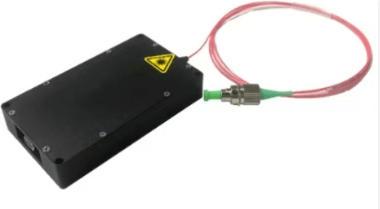Integration of 1550 nm Single-Frequency Lasers in Fiber Optic Networks

The demand for high-speed, long-distance, and reliable data transmission has driven the adoption of advanced laser sources in fiber optic networks. Among these, 1550 nm single-frequency lasers play a pivotal role due to their low loss in standard silica fibers, narrow linewidth, and high spectral purity.
Advantages of 1550 nm Lasers in Fiber Optics
The 1550 nm wavelength aligns with the low-loss window of standard optical fibers, minimizing signal attenuation over long distances. Single-frequency operation ensures minimal phase noise and stable output, which is critical for coherent communication systems, dense wavelength division multiplexing (DWDM), and high-speed internet infrastructure. The combination of these properties reduces signal degradation and enhances transmission quality.
Enabling Coherent Optical Communication
Modern optical networks increasingly rely on coherent detection to achieve higher data rates. Single-frequency lasers provide the spectral stability required for coherent systems, which can detect both amplitude and phase information of the signal. This enables higher-order modulation formats such as 16-QAM and 64-QAM, significantly increasing bandwidth efficiency. The narrow linewidth also reduces crosstalk in DWDM systems, allowing multiple channels to operate closely in the spectrum without interference.
Long-Haul Transmission and Network Stability
For long-haul fiber optic networks, maintaining signal integrity over hundreds of kilometers is challenging due to dispersion and nonlinear effects. The spectral purity and stability of 1550 nm single-frequency lasers mitigate these issues, ensuring reliable transmission across transoceanic and metropolitan networks. These lasers also support advanced dispersion compensation techniques and optical phase conjugation, improving overall network performance.
Integration in Next-Generation Fiber Networks
Single-frequency 1550 nm lasers are critical for next-generation networks, including 5G backhaul, data centers, and metro networks. Their integration into tunable laser modules allows dynamic wavelength allocation, improving flexibility and scalability. Moreover, their compatibility with fiber amplifiers, such as erbium-doped fiber amplifiers (EDFAs), enhances signal strength without compromising coherence or spectral purity.
Challenges and Future Prospects
Despite their advantages, implementing single-frequency lasers involves addressing challenges such as cost, thermal stability, and packaging. Ongoing advancements in semiconductor and fiber laser technology aim to develop compact, efficient, and robust single-frequency sources. The integration of these lasers into photonic integrated circuits (PICs) is expected to further reduce footprint and cost while maintaining high performance.
In conclusion, 1550 nm single-frequency lasers are essential components in modern fiber optic networks, offering low-loss transmission, spectral purity, and coherent communication capabilities. Their continued development and integration promise higher bandwidth, longer transmission distances, and more resilient optical networks for the future.
- Art
- Causes
- Crafts
- Dance
- Drinks
- Film
- Fitness
- Food
- Games
- Gardening
- Health
- Home
- Literature
- Music
- Networking
- Other
- Party
- Religion
- Shopping
- Sports
- Theater
- Wellness


